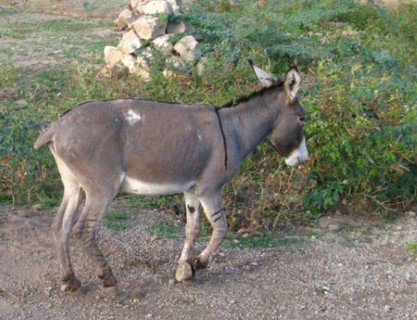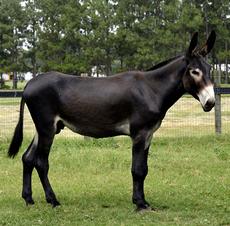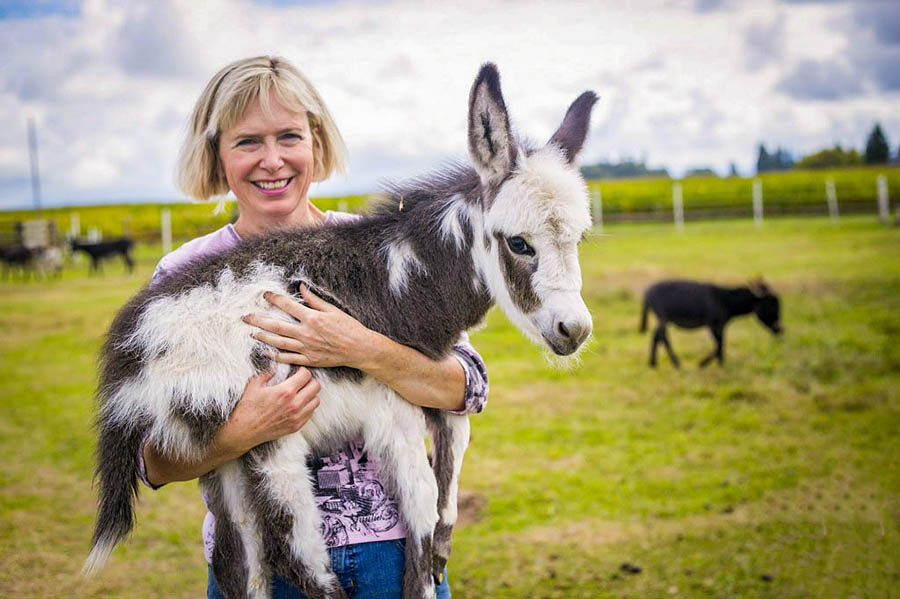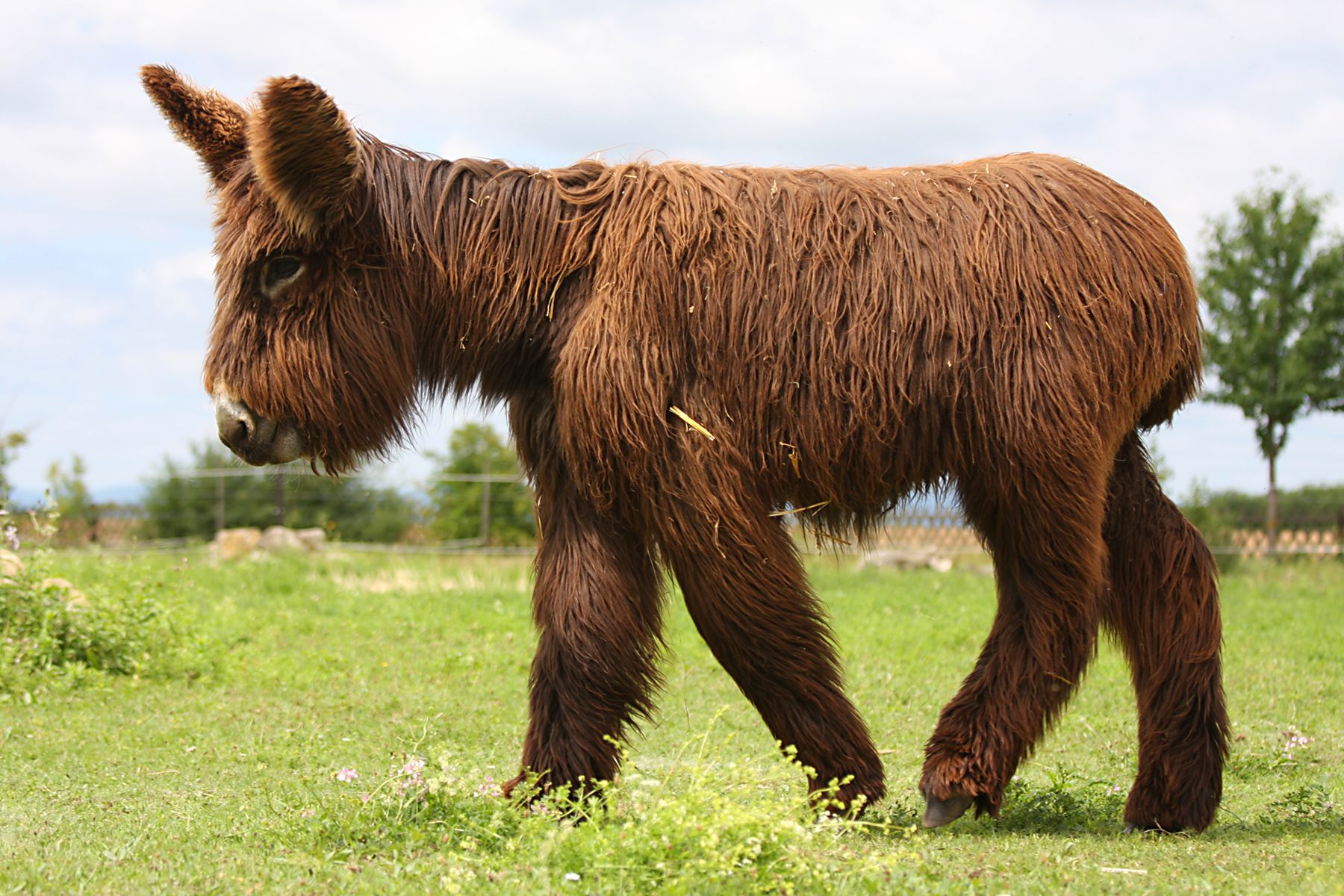A donkey or ass is a domestic horse. It is derived from the African wild ass, Equus africanus, and may be classified as a subspecies of Equus africanus asinus or as a separate species, Equus asinus.[1]: 2 [2]: 3715 [3] and has since been used primarily as a working animal.
There are over 40 million donkeys worldwide, mostly in underdeveloped countries where they are used primarily as livestock. Although working donkeys are often associated with people living at or below subsistence level, a small number of donkeys are kept for breeding, pets, and livestock protection in developed countries.
An adult male donkey is a donkey, an adult female is a female donkey, and an immature donkey is a foal of either sex. Male donkeys often mate with mares to produce mules. Khartoum is a rarer hybrid of a horse (perch) and a female donkey.
Traditionally, the scientific name of the donkey is Equus asinus asinus, based on the principle of precedence used for scientific names of animals. However, the International Commission on Zoological Nomenclature ruled in 2003 that if domestic and wild species are considered subspecies of a common species, the scientific name of the wild species takes precedence, even when that subspecies was described after the domestic subspecies.[7] This means that the proper scientific name of the donkey is Equus africanus asinus when it is considered a subspecies and Equus asinus when it is considered a species.[8][7]
There was a time when the synonym burro was the most common term for donkey. The first recorded use of the word burro was in 1784[9] or 1785.[10][11][12]: 239 While the word ass has equivalents in most other Indo-European languages, burro is an etymologically obscure word for which no credible equivalent has been identified. Hypotheses about its derivation include the following:
perhaps Spanish for its gift-like gravity; burro was also known as “the trumpeter king of Spain”.[11]perhaps a diminutive of pardo (dull greyish brown), a typical donkey colour.
possibly from the name Duncan.[10][14]perhaps of imitative origin.[14]From the 18th century onwards, burro gradually replaced ass and jenny replaced ass, which is now considered archaic. The change may be due to a tendency to avoid derogatory terms in speech, and may be comparable to the North American English substitution of cock for rooster, or of rabbit for rabbit, which was previously homophonous with cunny (a variant of the word cunt). In the late 17th century, changes in the pronunciation of ass and arse caused them to become homophones in some varieties of English.[12]: 239 Other words used for donkey in English from this time include cuddy in Scotland, neddy in southwestern England, and dicky in southeastern England;[12]: 239 moke is attested in the 19th century, and may be of Welsh or Romani origin.
Burro is a word for donkey in Spanish and Portuguese. In the United States, it is commonly applied to wild burros living west of the Rocky Mountains;[16] it may also refer to any small donkey.
The genus Equus, which includes all modern horses, is thought to have evolved from Dinohippus to an intermediate form, Plesippus. One of the oldest species is Equus simplicidens, which has been described as a donkey-headed zebra. The oldest fossil to date is about 3.5 million years old and was discovered in Idaho, USA. The genus appears to have spread rapidly throughout the Old World, with an age similar to that of Equus livenzobensis being recorded in Western Europe and Russia. ]
Molecular phylogenetic analysis shows that the most recent common ancestor of all modern horses (members of the genus Equine) lived about 5.6 million years ago (3.9–7.8 million years ago). Direct sequencing of the paleogenome of a 700,000-year-old Middle Pleistocene equine metatarsal bone discovered in Canada reveals that the most recent common ancestor (MRCA) dates to between 0 and 4.5 million years ago. The new era has been suggested to have occurred 4.07 million years ago. [19] The oldest branch is the Asiatic hyena (subgenus E. (Asinus), which includes the kuran, onager, and kian), followed by the African zebra (subgenus E. (Dolichohippus) and E. (Hippotigris)). All other modern forms, including the domestic horse (and many fossil forms from the Pliocene and Pleistocene), diverged into the subgenus Equus, which split off about 4.8 million years ago (belongs to 3.2–6.5 million years ago [20].
The ancestors of modern donkeys are the Nubian and Somali subspecies of the African wild ass. In Maadi, Lower Egypt, the remains of a domesticated donkey have been discovered dating back to the 4th millennium BC. c. And the domestication of donkeys is thought to have occurred well after the domestication of cows, sheep, and goats, between 7,000 and 8,000 BC. C. Nubian herders were probably the first to domesticate the donkey, replacing the cow as the main animal in their culture. The domestication of donkeys, which had the advantage of not requiring as much time to ruminate as ruminants, was essential to the development of long-distance trade in Egypt, thus increasing the fluidity of pastoral culture. Fourth Dynasty of Egypt, 2675 BC to 2565 BC. By 2675 BC, the wealthy members of this community owned over 1,000 donkeys, which were used in agriculture, dairy production, meat, and as draft animals. In 2003, the tomb of King Narmer or Hor Aha (two of the first pharaohs of Egypt) was excavated and the skeletons of 10 donkeys were discovered, buried in the manner customary for high-ranking men. These burials demonstrate the importance of donkeys to the early Egyptian government and its rulers.[25]
After the Christian era, in the late 4th millennium BC By 1800 BC, donkeys had spread to southwest Asia, with the main breeding center moving to Mesopotamia in 1800 BC. The breeding of large white donkeys made Damascus famous. At the same time, Syrian breeders developed at least three other breeds, including one favored by women for its ease of walking. The Muscat or Yemenite donkey was developed in Arabia. Donkeys were probably introduced to Europe at the same time as the introduction of viticulture, as they are associated with the Syrian god of wine Dionysus in the 2nd millennium BC. Both Greeks spread to many colonies, including present-day Italy, France, and Spain. The Romans spread them throughout the empire.[24]
The first donkey arrived in America on the ship of Christopher Columbus’s second voyage, landing on the island of Hispaniola in 1495.[26] The first animals to reach North America were probably two animals brought to Mexico by Mexico’s first bishop, Juan de Somárraga, on December 6, 1528, while the first donkeys to reach what is now the United States may have been brought to Mexico. They crossed the Río Grande with Juan de Oñate in April 1598. From that point on, they spread northward and were used in missions and mines. Donkeys existed in present-day Arizona by 1679. During the 19th-century gold rush, donkeys were the animal of choice for early gold seekers in the western United States. When the placer mining boom ended, many escaped or were released, creating feral populations.
Donkeys vary greatly in size depending on breed and environmental conditions, ranging from 90 cm (35 in) to 150 cm (59 in). Life expectancy 12 to 15 years; [39] In more fortunate countries, they can live between 30 and 50 years.
Donkeys are adapted to desert environments. Like wild horses, wild donkeys live solitarily in dry areas and do not form harems. Each adult rabbit creates a home range; donkeys can breed over a large area. The donkey’s loud call or bray, which usually lasts about 20 seconds and can be heard two miles away, can help communicate with other donkeys in large deserts. Donkeys have large ears that can pick up distant sounds and help cool the donkey’s blood. Donkeys can defend themselves by kicking, either with their front or hind legs. Their call, called a bark, is often rendered in English as “hee haw”.
Cross on the back
Most donkeys have shoulder and shoulder stripes, primitive markings that form a distinctive cross-shaped pattern on the back.
Breeding
A donkey is usually pregnant for 12 months, although the gestation period varies from 11 to 14 months,[6][47] and usually gives birth to a single foal. Twin births are rare, but much less common than in horses.[6] 1.7 percent of donkey pregnancies result in twins. Both birds have a 14 percent survival rate. In general, the fertility of donkeys is lower than that of horses (i.e., less than 60-65% of mares).
Although gilts come into heat within 9 or 10 days of giving birth, their fertility remains low and it is likely that their reproductive tract has not returned to normal.[6] Thus, it is common to wait one or two more heat cycles before breeding, unlike mares. Jennies are generally very protective of their foals, and some will not come into heat until they have a foal by their side. Due to the breeding season and the length of the jenna’s pregnancy, the jenna will have fewer than one foal per year. For this reason and the longer gestation period, donkey breeders do not expect a foal every year, as horse breeders often do, but may plan for three foals in four years.
Donkeys can interbreed with other members of the horse family, and they are most commonly interbred with horses. The mule, a hybrid of a jack and a mare, is prized in many countries as a working and riding animal. Some large donkey breeds, such as the Asino di Martina Franca, the Baudet du Poitou, and the Mammoth Jack, are bred exclusively for the production of mules. A hybrid between a stallion and a jenny is a pony and is less common. Like other interspecies hybrids, hinnies and colts are usually sterile. Donkeys can also breed with zebras, in which case the offspring are called zonki, among other things.
The earliest documented donkey hybrid was the kunga, used as a draft animal in the kingdoms of Syria and Mesopotamia in the second half of the 3rd millennium BC. The crossing of a captive male Syrian wild donkey with a domesticated female is the earliest known example of human-directed animal hybridization. They were produced at a breeding center in Nagar (today Tell Brak) and were sold or given as gifts throughout the region, where they became important status symbols, pulling royal chariots and carts and were slaughtered to be buried with dignitaries. people of status. They fell out of favor after the introduction of the domestic horse and its donkey hybrid, the mule, into the region in the late 3rd millennium BC.
A donkey (yak) crossed with a female mare produces a mule, and a male horse crossed with a female henna produces a foal. Horse-donkey hybrids are almost always sterile because their developing gametes do not complete meiosis. Lower progesterone production in Jenny can also lead to premature embryo loss. In addition, there are reasons not directly related to reproductive biology. Due to differences in mating behaviors, farmers are often more willing to breed mares than stallions are to breed chickens. In addition, mares are generally larger than yens, allowing them more room in the uterus for the foal to grow, resulting in a larger animal at birth. Mules are generally considered easier to handle and also physically stronger than horses, making them more attractive to breeders.
The offspring of a cross between a zebra and a donkey is called a zonkey, zebroid, zebra or zedonk. [82] Zebra mullet is an older term, but is still used in some areas. The above terms usually refer to hybrids produced by crossing a male zebra with a female donkey. A zebra, zebra and zebrinny horse is a cross between a female zebra and a male donkey. Zebras are rarer than zedons because captive female zebras are more valuable when they become full-fledged zebras. There are enough female zebras bred in captivity to prevent hybridisation; there is no such restriction on the number of donkeys intended for breeding.






